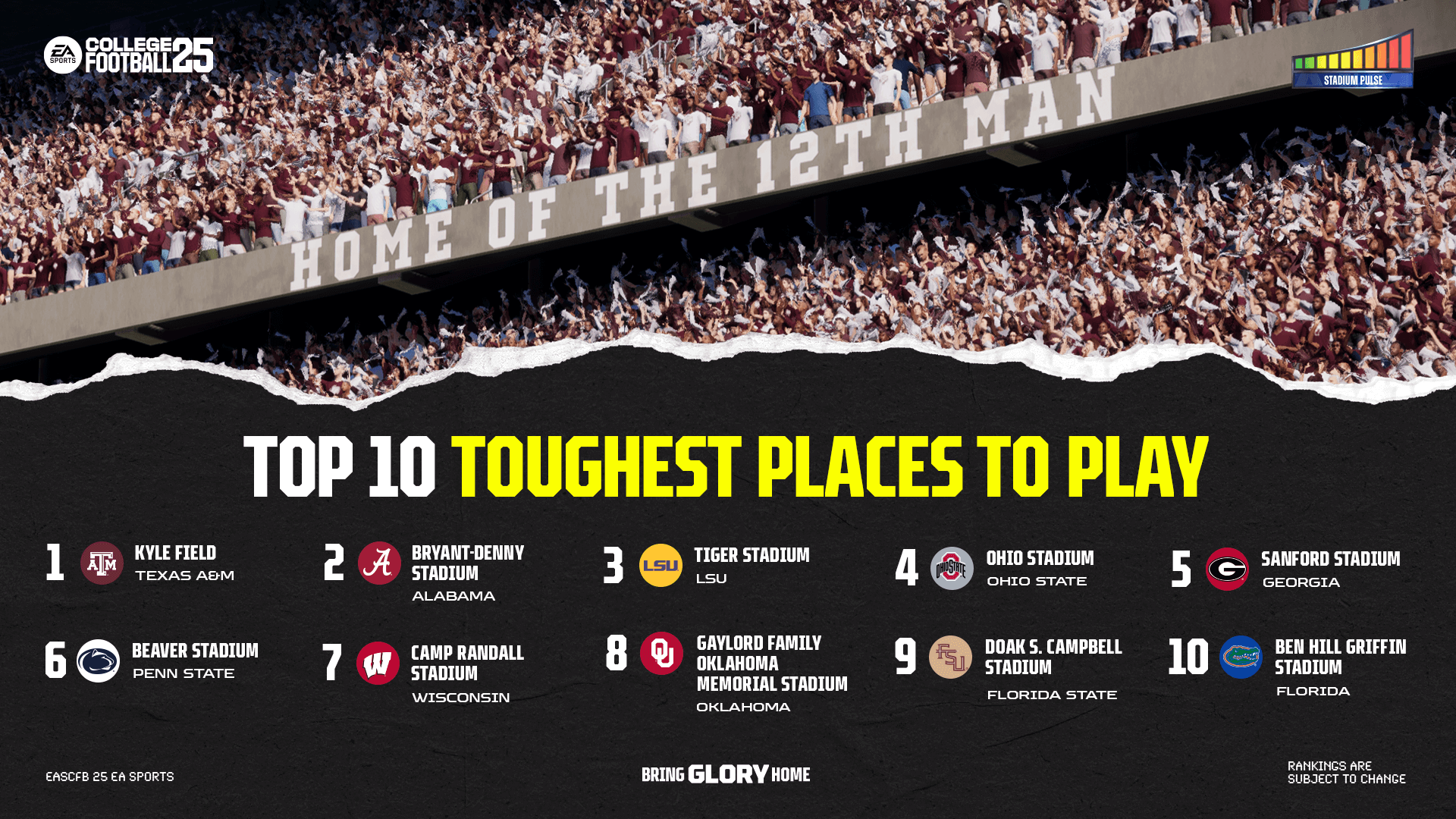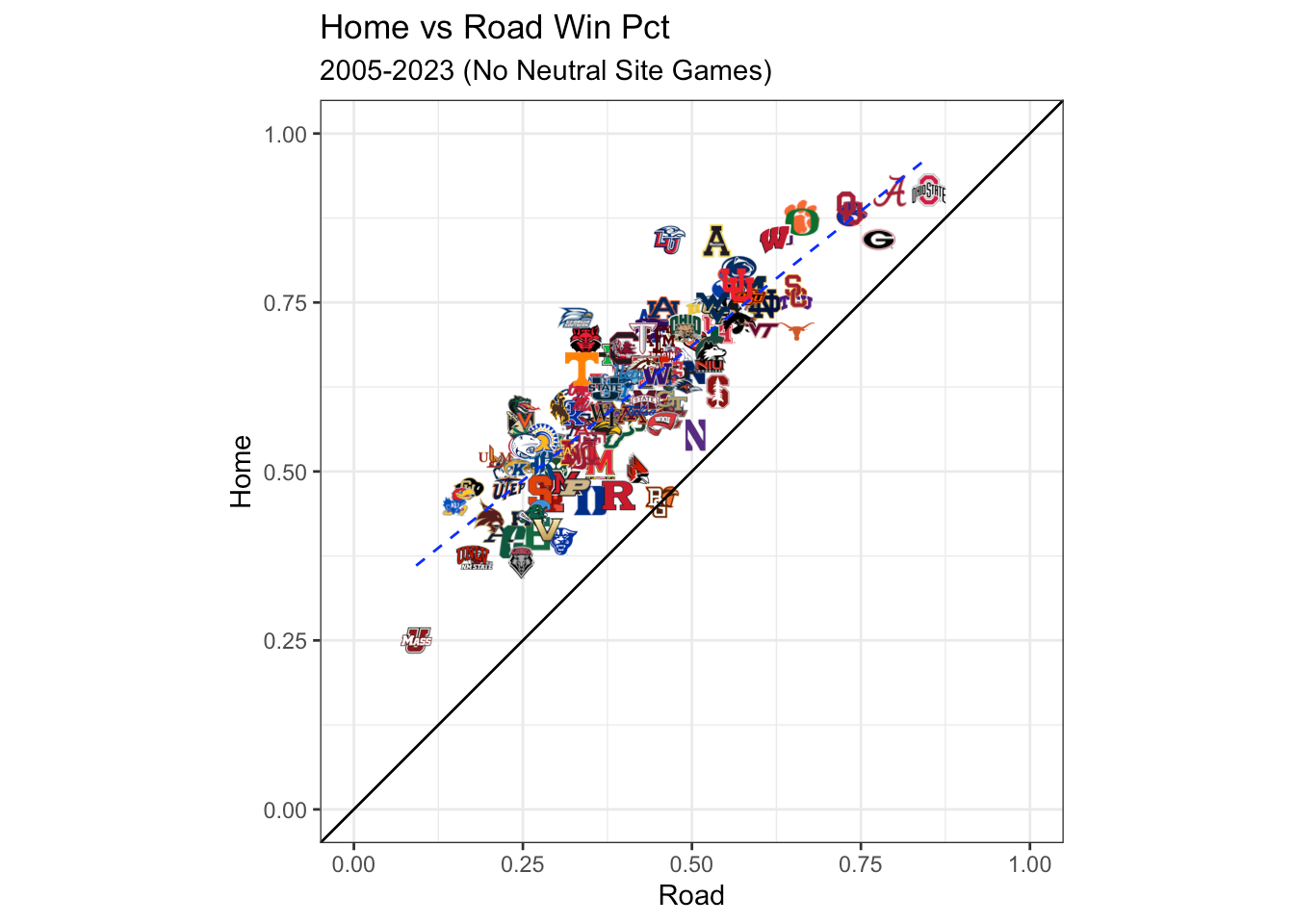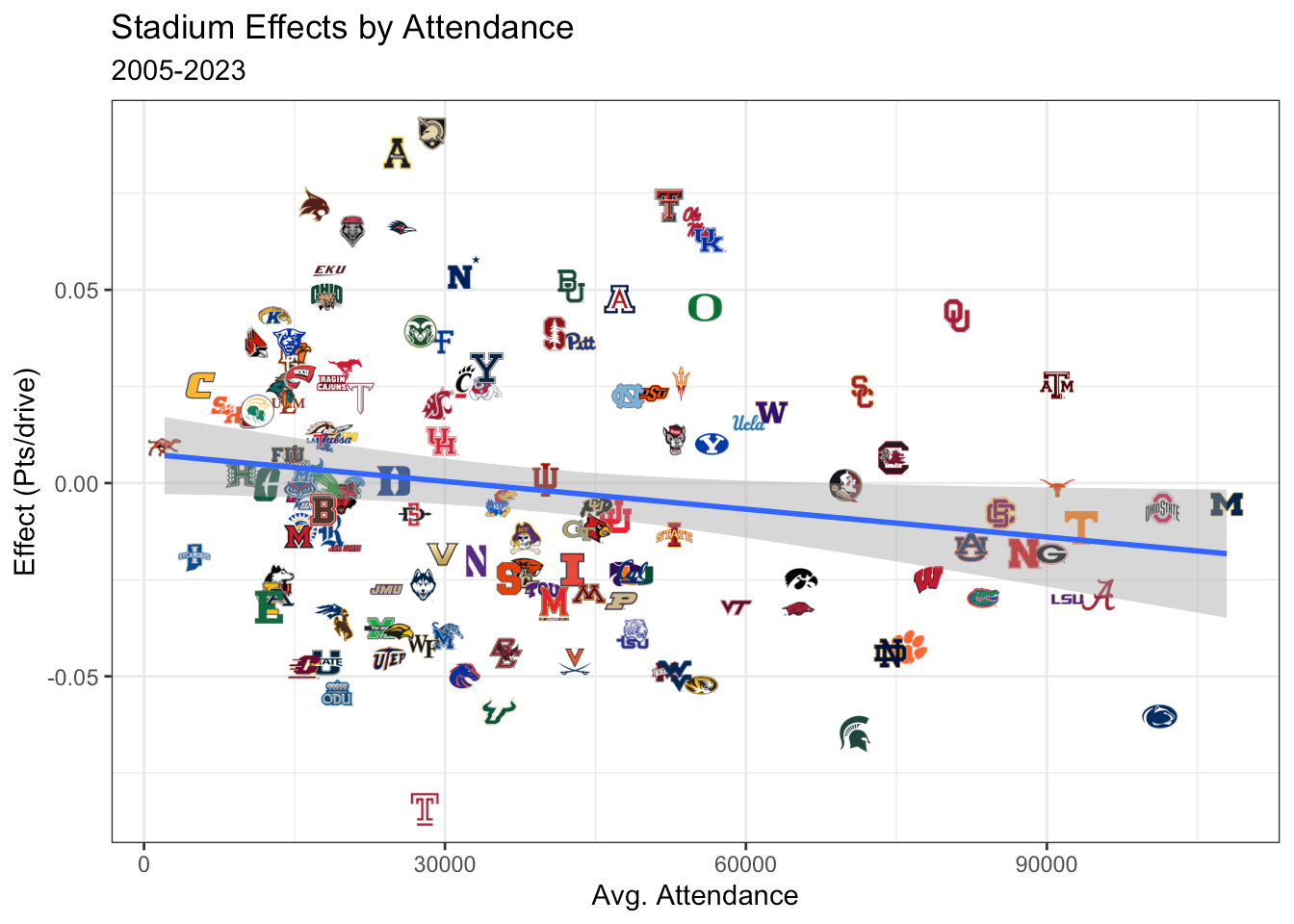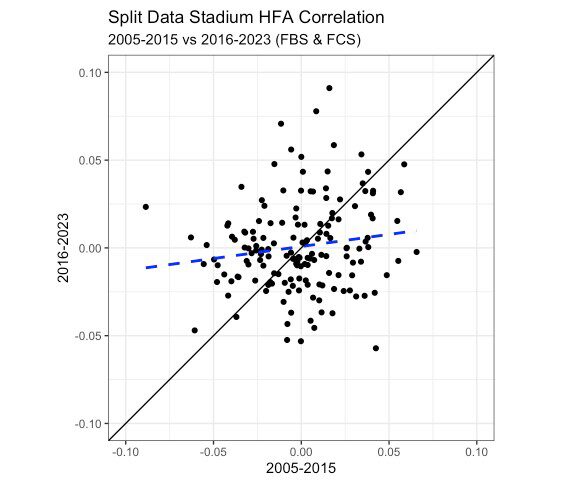Who has the Biggest Home-Field Advantage?
It’s Not Who You Think.
Why EA Sports new college football game’s home field advantage rankings are not backed by data.
Author: Paul Sabin, Senior Sports Analytics Fellow, Wharton Sports Analytics and Business Initiative
Published: July 9, 2024
EA Sports Hardest Places to Play
College Football fans (including me) cannot wait for the new College Football 25 video game to come out. As part of the game there are team rankings provided by EA sports in addition to rankings of the 25 hardest places to play.
The top of the hardest places list is a who’s who of college football. EA Sports mentions the rankings of the toughest places to play come from a combination of “home winning %, home game attendance, active home winning streaks, team prestige, and more.”

Good Teams – All They Do Is Win
Can we disentengle home team ability from a home field advantage? Alabama’s winning percentage at home in the Nick Saban era (2007-2023) was 93% which is the highest of any FBS team in that timespan.
So is Bryant-Denney Stadium a particularly hard place to play? In short of course it is. Just look at how rarely Alabama has lost there. But there’s no evidence that it is any more difficult of a place to play than the average college football home venue after adjusting for the home team. Don’t believe me? Well in 21 neutral site games over that same time Alabama had a 95% winning percentage and even had a 84% winning percentage on the road. So while 84% on the road is worse, Alabama’s road schedule is almost exclusively against SEC teams while they typically have one or two non-power conference (including FCS) home games each year.
While they do boast a raucous crowd and it can be very hot and humid in Tuscaloosa, but the most difficult thing about winning there is the players wearing crimson on the field, not the stadium or the crowd.
Home vs Road
Theoretically, all else being equal, teams that have a bigger home field advantage should have a bigger difference of performance at home vs on the road. That could be in winning percentage or in efficiency (points or EPA per play or drive). The problem is, in college football, nothing is equal between teams or between road and home schedules. Let’s look at winning percentage the last 19 seasons on the road versus at home.

If everything else was equal, teams with bigger HFA would be further away to the top and left of the dotted blue line and teams with smaller HFA would be below the dotted blue line. The black line represents an equal winning percentage on the road and at home. There isn’t a school in this time span with a worse home winning percentage than road winning percentage.
What is Home Field Advantage?
Home field advantage is well studied and documented. But do some teams have a larger home field advantage than others? In order to answer that we first need to talk about what home field advantage is and what it isn’t. Now there may be differing opinions on this but here is mine.
I make the assumption that any HFA unique to a team should not involve any factors that involve the visiting team. So while travel and timezone changes matter, the extent thereof is impacted based on where the visiting team is coming from.
Fans, weather conditions, or even elevation can then be considered part of a team’s unique HFA and won’t be accounted for separately in the model.
I assume the difference in performance of efficiency at home vs on the road, after accounting for these other “environmental” effects to be a team’s home field advantage. I model a teams home field advantage above the average HFA in college football as

The 𝑔() functions are splines with 2 internal knots to account for nonlinear effects of travel and elevation change. Elevation change is included because only if a visiting team doesn’t play at elevation normally is it a factor (recall my rule that things dependent on the visiting team shouldn’t be considered home field advantages above the average).
Data
I am missing venues for some of the data, a total of 330 games out of 15618 . A summary of the total missing venues for the each season is shown below.
| season | games |
|---|---|
| 2005 | 49 |
| 2006 | 50 |
| 2007 | 57 |
| 2008 | 35 |
| 2009 | 28 |
| 2010 | 28 |
| 2011 | 33 |
| 2012 | 26 |
| 2013 | 24 |
Using the latitude and longitude of the game’s stadium and each team’s respective home stadiums I calculate the distance traveled for each team and any effects of elevation. For the purposes of this study I will not adjust capacity differences as that can reasonably be part of the home field effect. I do show the correlation between my estimates and attendance later on.
The estimated average home field advantage for all teams from 2005 to 2023 is 0.11 points per drive for the home team. With an average of 12.5 offensive drives for each team we can estimate the average home field advantage is 2.8 points per game.
While I make estimates for average team ability since 2005 in each season of the dataset and each venue they played at in that timespan, I am only assessing the most recent stadium a team has played in for the following analysis if a team has had more than one home stadium since 2005.
Even with 18 years of data, it is difficult to detect if a team has a stronger home field advantage than another. That being said, 2 of them show evidence of being a weaker home field advantage than the average college stadium and 9 show significant evidence of having a stronger home field advantage than other stadiums.
There are a total of 247 current unique home stadiums between FBS and FCS that I have in my dataset. If I am assessing 247 teams home stadiums in my dataset to see if they have a stronger or weaker home field advantage than the average college football team, if there is no effect I would expect 20 percent of the teams to have a posterior probability greater than 0.80 of being different than the average home field advantage (HFA). That would be about 49 teams. In fact my analysis shows that only 11 teams meet such a threshold. Thus, even the teams we do observe with a home field advantage are likely due to chance.
Despite the inconclusive effects for HFA for most teams, I am able to at least provide an estimate for each team’s home stadium, even if the evidence isn’t that strong. This estimate shows the estimated HFA as points per drive for each home team above that of an average home field advantage.
We see even for Army (the highest effect) once we multiply its posterior mean home effect by the average drives in a game, it comes out to 2.2 points per game which is about double the estimated average home field advantage effect of 2.8 points per game (assuming an average number of drives per game).
Attendance
One of the factors in the EA Sports rankings was the number of fans in the stands but our model doesn’t show fan attendence as correlated with the stadium specific home field advantage. It even appears that attendence is slightly negatively correlated with the specific home field advantage effects. This goes against intuition as crowd noise is believed to be able to impact penalties like false starts and also referee behavior.

There is an important confounder here which is team ability. Better football schools traditionally have bigger stadiums and fan support. Perhaps teams with better players and by extension more fans also have players that are less likely to be impacted by opposing fans or their own fans.
This also brings up another point which is that this model solely measures how teams play at their home compared to the average home field advantage. For Army this could be for reasons around the strict routine of West Point or its unique offense which lends itself to play better at home than the road that have nothing to do with Michie Stadium. Then again who wouldn’t be affected by military cannons blasting at you and soldiers jumping out of helicopters?
In order to fully disentangle a team’s typical performance on the road against the effect of the stadium they’re playing out, additional effects for a team’s road performance need to be added to estimate this. With already small effects for stadium specific advantages without all those additional parameters, this is unlikely to increase the significance of these effects.
Does This Persist?
It’s one thing to have a ranking of teams, but if we split our data in half would we get similar results in both datasets? In other words, is this effect real or is it just a ranking because if you model something it will order teams in some way?
I split the data up into two unique groups:
- Games between 2005 and 2015
- Games between 2016 and 2023
Then I fit the exact same model to both of them to get an estimate of the effect of the venue above the average home field advantage.
The correlation between the two time periods is not zero and in fact is positively correlated with posterior probability of almost 1 but it is still fairly weak at about 0.15.
| Split Data Stadium HFA Correlation | ||
|---|---|---|
| 2005-2015 vs 2016-2023 (FBS & FCS) | ||
| Corr. (Post. Mean) | Corr. (Post. Median) | Num of Stadiums |
| 0.148 | 0.147 | 156 |
We can visualize it graphically as well,

Takeaways
Generally it is very hard to estimate if one team or stadium has a stronger home field advantage than another. That being said, there are a handful of teams that may have enough evidence of a stronger homefield advantage than what you would think. These teams are not the typical powerhouse teams with large crowds. The reasoning behind why these teams may have a larger HFA is solely conjecture at this point and the distribution of all posterior mean stadium effects falls roughly inline with the expected distribution of HFA effects observable by noise if no stadium had a larger HFA than another.
Beyond this study, a more interesting question perhaps is if there is a statistically significant effect on false start rates by stadium beyond what you would expect with multiple testing. If that is the case that is evidence of a home field advantage beyond average, but the effect size might be small enough to not make an impact in an analysis like this one.
This would be akin to my analysis on home crowds affecting college basketball free throw shooting in a previous post.


